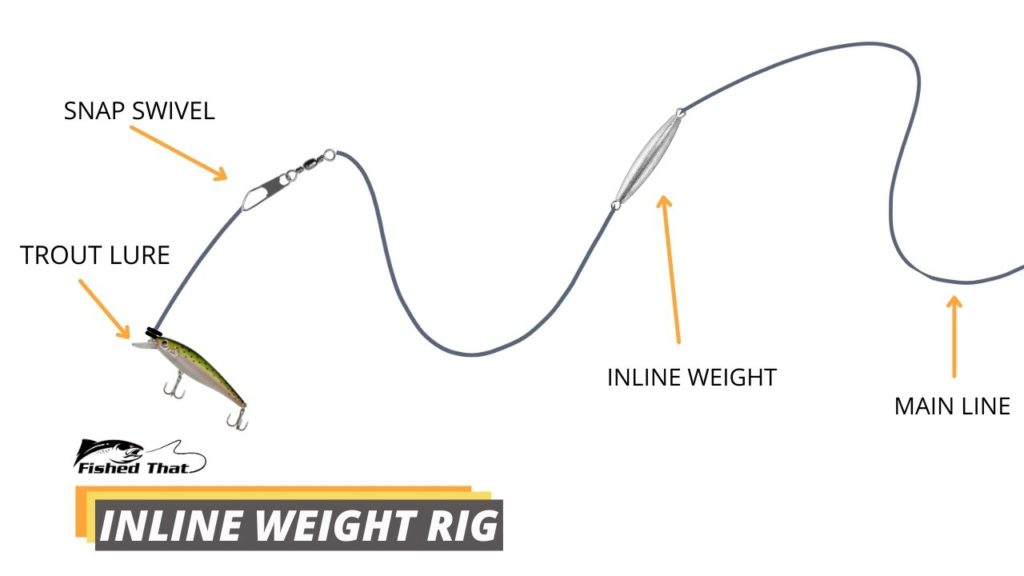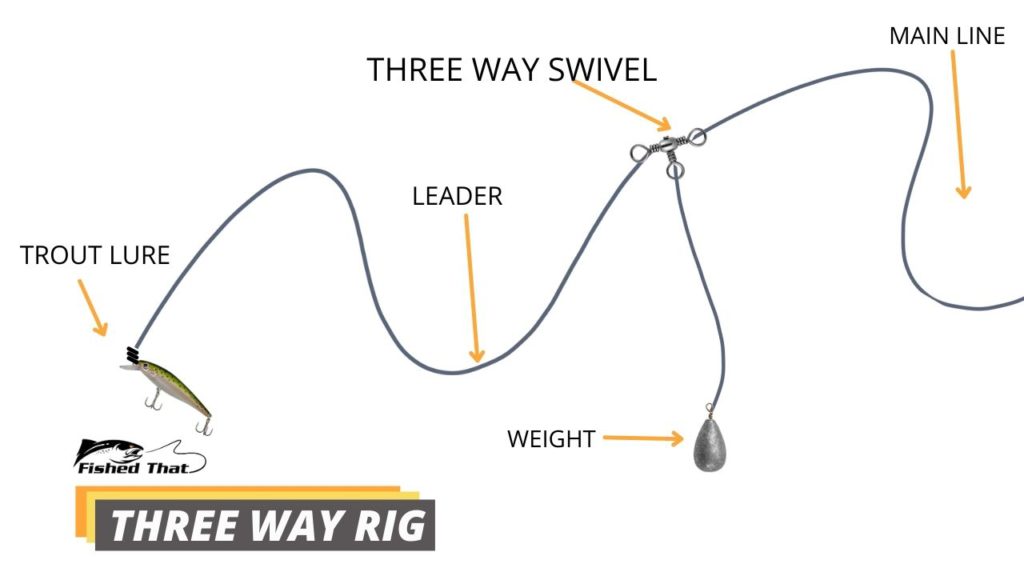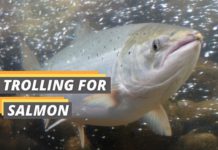Most beginner trout anglers shift their focus to other species when hot summer months hit, but it doesn’t have to be. This is because trolling for trout is the most effective way to reel in the elusive, cold-water species, even in the middle of summer. You can even use this technique to catch other species.
Here’s everything you need to know about trolling for trout, including tips and tricks, the ideal trout trolling setup, and the best lures.
What Is Trout Trolling?
Trolling involves dragging lines off the back or sides of a slow-moving boat. This technique is the most common way of fishing for trout, especially during the hotter months of summer when the fish tend to occupy the deepest ranges of their preferred depth.
A standard trout trolling gear includes using downriggers, particular trolling lures, and lines. These items are made to help the fishing line maintain the desired depth and attract fish while being towed behind a boat.
Expert Tip: Trolling is not only effective for lake trouts. You can also use this fishing technique to catch Steelhead, Brown Trout, and Atlantic Salmon.
3 Reasons Why You Should Troll
There are three main reasons to go trolling for Lake Trout:
- Allows you to fish in deeper water: When you’re trolling, you can fish deeper than if you were casting. The constant slow motion of trolling in a boat allows lures like deep divers to easily reach their maximum depth faster than if you were anchored in place casting.
- Cover more area: Moving in a boat at a slow speed allows you to cover a lot of areas. Using a fish finder will also help mark the fish around the boat and at varying depths.
- Lake Trout are roaming predators: Lakers are not known for staying in one place and ambushing their prey. They cruise the deeper waters around structures like bays, drop-offs, islands, or pilings.
Trolling for Trout With Downriggers

There are plenty of anglers that prefer trolling with downriggers. The benefit of using downriggers is that they make it infinitely easier to get your lures or bait to the desired depth. And they can do so precisely.
They come in a large variety, from hand cranks to an electronic push of a button too. Also, most downriggers tend to be rather affordable. However, many would rather be trolling without downriggers because it takes away from the authenticity of the experience.
How to Use Downrigger for Trout Trolling
Using downriggers may seem intimidating to use. However, this piece of equipment is pretty straightforward to operate, whether you opt for a manual or electric downrigger.
- Attach the downrigger and downrigger bracket.
- Position the boom perpendicular to whichever side of the boat it’s on.
- Put the downrigger weight on the end of the cable line and let it drop into the water.
- Fix the downrigger clip to either the cable or the weight.
- Let out 5 to 50 feet of line.
- Have the boat in forward gear to help take out the line.
- Attach the fishing line to the downrigger clip.
- Release the reel spool to slowly drop the line and downrigger in a controlled manner by using your finger or thumb to manage the speed.
- Do so until you reach the desired depth, then close the bail or engage the reel.
- Place your fishing rod in the rod holder.
- Begin trolling at your preferred speed.
Trolling for Trout Without Downriggers
If you find using downriggers a cheat code to catch trouts, you can always skip this piece of equipment. It makes fishing more authentic, but you can also put your trout knowledge to the test – it takes skill and experience to determine the correct depth when trolling for trout without downriggers.
There are a few different ways and gear that will help if you’re an angler that chooses to go this route.
Flat Lining
This is the simplest method of trolling that you can apply without the help of downriggers. There are no extras or weights that will be attached to your line other than the chosen trout trolling lures.
Expert Tip: This is considered a near-surface technique because the lures will not reach anything beyond a moderate depth. It is a good method for trolling lures like lipped divers, crankbaits, and jigs.
Planer Boards

If you want to cover more area, you can use planer boards. This device, which can either be wood or foam, attaches to your fishing lines and pushes them away from the boat. Many anglers use multiple planer boards in their trolling for trout set up to spread out multiple lines and prevent tangles. Some use weights to help the lures reach the desired depth.
To use:
- Cast your line.
- Attach the line to the two clips on the planer on the side you casted from.
- Release more lines and let the planer float to the side of the boat to the desired distance.
- Begin trolling.
- The movement of the planers or tattle flags will alert you of a bite.
Lead Core Line

Trout trolling anglers also use a lead core line, which is just a fishing line with a lead core. This makes it much heavier than monofilament and doesn’t require attaching additional weights.
Not only will it drop to whatever the desired depth is quickly, but it is also color-coded to help you determine depth. It is also marked with ten different colors, and each section is 30 feet in length. Ideally, you want a 6-8 lb line for trolling.
Trout Trolling Setup: 3 Setups You Should Try
Just as there are different trolling methods for trout, there are different setups as well. And knowing the different varieties and adding them to your fishing arsenal will increase your chances of success, whether you are after rainbow trout.
There are three styles that you’ll often hear of. They include inline weight rigs, 3-way swivel rigs, and flasher rigs. Each of these trolling setups offers different actions to attract trout, can combine other lures or bait, and can reach a variety of depths.
Trolling Rig With Inline Weight

This trout trolling setup allows you to switch lures quickly and is attached directly to the weight via a swivel. When using this method, you’ll need to use an improved clinch knot to tie the swivel to the fishing line.
The swivel allows you to change lures easier and faster. Once the swivel is secured directly to the line or the end of a 6-foot fluorocarbon leader, you should clip the swivel to the front eye of an inline weight. This setup is especially effective for fish suspended off of the bottom.
3 Way Rig for Trout

The simplest setup to troll trout lures with is the 3-way swivel rig, and it functions the best in lakes.
As its name suggests, it uses a 3-way swivel that attaches the main line, a dropper line (often combined with one or more weights), and a leader line which the lure is attached to.
This is an extremely versatile setup because you can have varying weights to reach any depth. You can also utilize different lures and baits to achieve different actions.
You can do so by using the dropper line to attach a different lure or weighted hook and worm instead of a weight. Then the leader line can sport a diving crankbait or similar.
Flasher Rig for Trout

This popular setup uses an extra-large colored or metallic blade that will spin in the water, creating vibration and shine similar to the flashes of live baitfish that trout usually prey on.
Expert Tip: The flasher is positioned 8 to 20 inches from where the lure is attached.
Here’s how you can use a flasher rig for trout trolling:
- Attach a snap swivel to the mainline.
- Tie, then tie the line to a barrel swivel.
- Attach a weight to the snap swivel and a 2-foot leader to your flasher and the barrel swivel.
Keep in mind that flashers and dodgers are not the same. The latter wobbles and is better for slower trolling speed.
Trout Trolling Lures: What Is the Best Lure?
There is no shortage when it comes to trolling lures for trout fishing. Anything from spoons and crankbaits to jigs and rooster tails are excellent options.
However, certain lures work better depending on the season. Each season, Lake Trouts move to different depths within the water column as they have little tolerance for temperatures above 50 degrees Fahrenheit.
This means during the cooler months of early spring, fall and winter, you can find them in shallower water ranging from 10 to 30 feet deep. When the water temperatures begin to heat up in late spring into summer, they can move to depths of 100 to 200 feet.
Their behavior also changes, so the kind of lures you use for each season will reflect that.
- During Spring: Spring calls for bright, high-action lures since the trout will be aggressive and hungry coming out of the winter season. The best lures to use at this time include Needlefish spoons, Rapalas, and spinners.
- During Summer: Use less bright lures during summer trolling for trout. Some of the summer favorites are wedding ring lures and Needlefish spoons.
- During Fall: The fish will be coming up to shallower water as the temperatures begin to cool at this point of the season. This is the perfect time to use lures like Kastmaster spoons, Z-Rays, or Cripplures.
Conclusion
Trolling is extremely popular and by far the best way to fish trout on large water and during summer. And with two trolling for trout techniques – with or without downriggers – and three different trolling rig setups, you can find a suitable tactic for your needs.
Remember, there is no lack of creativity when it comes to fishing! So, trying out new or unusual combinations of methods and setups could lead to surprising results.
Table of Contents



